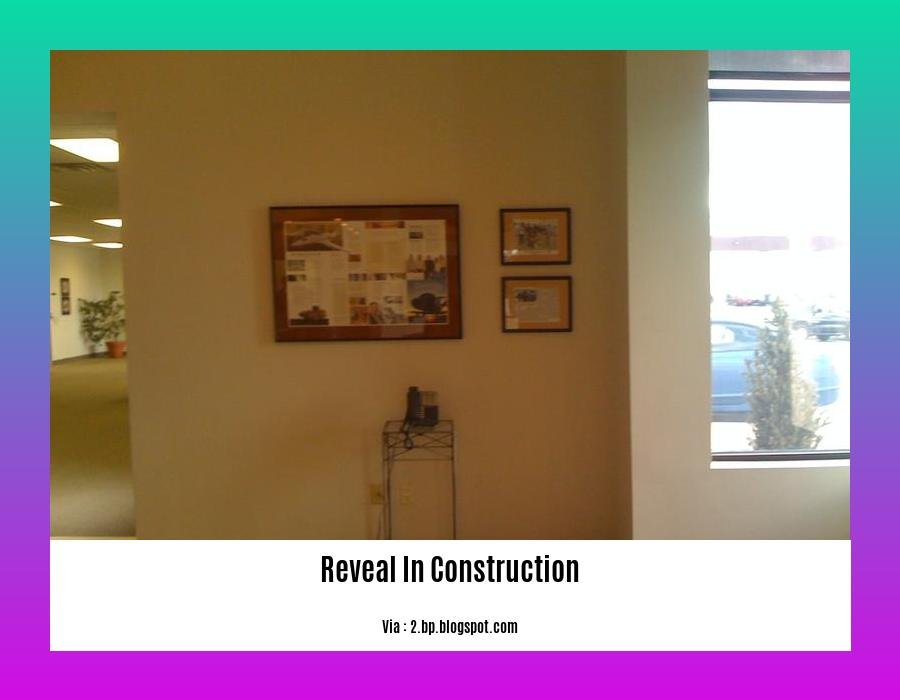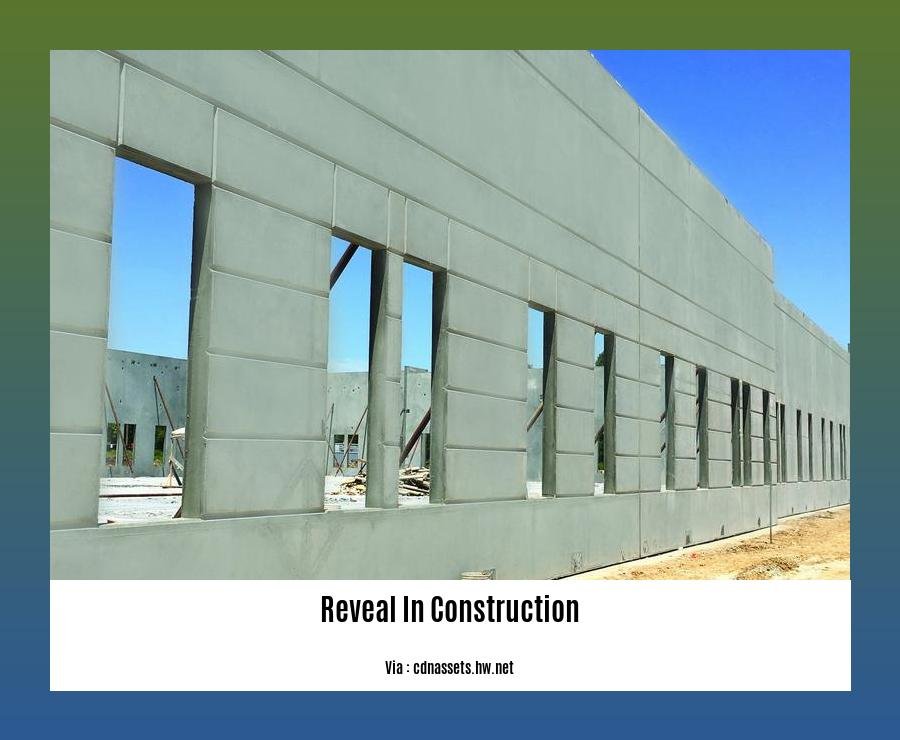Explore the art of reveal in construction in our latest article, [- The Art of Reveal in Construction: Enhancing Aesthetics and Functionality]. Here, we delve into the intricacies of reveal design and its profound impact on both the visual appeal and structural integrity of buildings. Join us as we unveil the secrets behind creating reveals that seamlessly blend aesthetics and functionality.
Key Takeaways:
- Reveals create a recessed or “box-like” framework around windows or doors.
- They enhance the visual appeal and aesthetics of construction.
- Reveals improve functionality by providing a buffer zone between the window/door and the wall.
- They can enhance the durability of the construction by protecting the edges of the window/door frame.
- Reveals can run vertically, horizontally, or diagonally.
- In carpentry, reveals resemble rabbets, but are constructed from separate pieces of wood.
- The setback distance of reveals can range from 3/16″ (5 mm) to 1/2″ (12 mm).
- Reveals are also known as rustication or false joints.
Reveal in Construction: Enhancing Aesthetics and Functionality

Understanding Reveals
In construction, a reveal is an inner surface that creates a box-like framework around windows or doors. By setting back the face molding from the edge, reveals enhance visual appeal and structural integrity.
Types of Reveals
- Architectural Reveals: Found in entrances and recesses, they add depth and character to a building’s exterior.
- Carpentry Reveals: Used at the edge of doors and windows, they provide a uniform setback for face molding.
Benefits of Reveals
- Improved Aesthetics: Reveals create a clean and sophisticated look, adding depth and interest to any space.
- Increased Functionality: They protect windows and doors from moisture and drafts, improving insulation and energy efficiency.
- Enhanced Structural Integrity: By providing support to the window or door frame, reveals reduce the risk of damage from stress or impact.
Designing with Reveals
- Consider the Size: The reveal should be proportionate to the size of the window or door, typically ranging from 3/16″ to 1/2″.
- Choose the Material: Reveals can be made from a variety of materials, including wood, metal, or stone, to match the surrounding décor.
- Plan for Water Drainage: Ensure that the reveal design allows for water to drain away from the window or door, preventing damage to the surrounding structure.
Conclusion
Reveals in construction play a crucial role in enhancing the aesthetics, functionality, and durability of windows and doors. Understanding their purpose and design principles enables architects and builders to create aesthetically pleasing and structurally sound structures.
Understanding the complexities of construction? Delve deeper into specific topics with our comprehensive resource on:
-
Learn about the importance of remedial works in construction
-
Explore innovative techniques in residential roof construction
-
Discover the concept and benefits of retrofit in construction
-
Understand the role of reveals in building construction
-
Get insights into road construction equipment
Reveal Design Considerations: Enhancing Visual Appeal and Architectural Detailing
What’s a Reveal in Construction?
Think of a reveal as an architectural indent or recess that adds depth and character to your building’s walls, ceilings, windows, and doors. It’s not just about aesthetics; reveals play a functional role too.
Consider This:
- Visual Appeal: Reveals create a stunning effect by adding a sense of depth and dimension to your building’s facade.
- Architectural Detailing: They allow for intricate ornamentation, giving your building an air of sophistication and refinement.
- Scale Illusion: Reveals can make a building appear larger or smaller, depending on their placement.
Impact on Your Project:
- Budget: Reveals can add to the cost due to extra materials and labor.
- Design: They influence the overall design and aesthetics of your building.
- Challenges: Water drainage and material selection are important factors to consider when designing reveals.
Key Takeaways:
- Reveals enhance visual appeal, provide architectural detailing, and create a sense of scale.
- Consider budget, design, and challenges when incorporating reveals into your projects.
Sources:
Reveal Design Best Practices

In construction, reveals are recessed areas that create depth and character. They enhance aesthetics and offer functional benefits. Mastering reveal design best practices elevates your construction projects.
Planning and Design
- Define the purpose: Determine the desired aesthetic and functional outcome of the reveal.
- Size and Proportion: Calculate the appropriate reveal size based on the window or door dimensions. Consider the room’s scale and overall design.
- Material Selection: Choose materials that complement the building’s character and match the surrounding surfaces.
- Water Management: Ensure proper drainage to prevent water accumulation and damage.
Implementation and Execution
- Precise Measurements: Measure accurately to ensure the reveal fits perfectly.
- Skilled Craftsmanship: Install the reveal with precision, paying attention to alignment, levelness, and miter joints.
- Inspect and Adjust: Regularly check the reveal for any flaws or damage and make necessary adjustments.
Maintenance and Care
- Cleaning: Keep the reveal clean to maintain its aesthetic appeal. Use appropriate cleaning methods to avoid damage.
- Sealant Maintenance: Inspect and reapply sealant as needed to prevent leaks and moisture penetration.
- Repairs: Address any damage promptly to restore the reveal’s functionality and appearance.
Key Takeaways:
- Reveals enhance visual appeal, create depth, and provide functional benefits.
- Reveal Design Best Practices encompass planning, design, implementation, and maintenance.
- Proper planning and execution ensure the desired aesthetic and functional outcomes.
- Regular maintenance and care preserve the reveal’s beauty and longevity.
Sources:
– Storables: What Is Reveal In Construction?
– WikiDiff: Reveal vs Review
Reveal Design Trends
Reveal trends are transforming architectural design, adding visual interest, depth, and functionality to buildings. By incorporating reveals into structural elements like walls, ceilings, windows, and doors, architects and designers are creating visually appealing and functional spaces.
Types of Reveals
Architectural Reveals: Enhance exterior depth and character, adding dimension to facades and creating shadows that highlight architectural details.
Carpentry Reveals: Provide a setback for face molding at windows and doors, framing them and enhancing their visual impact.
Benefits of Reveals
- Improved Aesthetics: Create visual depth and interest by adding layers and shadows to surfaces.
- Increased Functionality: Protect from moisture and improve insulation by providing a buffer zone around windows and doors.
- Enhanced Structural Integrity: Support window and door frames, reducing damage risk by distributing weight evenly.
Design Considerations
- Size: Proportionate to the window or door size, typically ranging from a small reveal to a large, dramatic one.
- Material: Variety of options to match décor, including wood, metal, stone, and even glass.
- Water Drainage: Allow water to drain away from the window or door to prevent moisture damage.
How to Create Reveals
- Determine the desired reveal size and material.
- Cut the material to the appropriate dimensions.
- Attach the reveal to the structural element using appropriate fasteners or adhesives.
- Check for level and square, and make any necessary adjustments.
Key Takeaways:
- Reveals enhance architectural detailing, depth, and visual interest.
- Types include architectural and carpentry reveals.
- Benefits include improved aesthetics, increased functionality, and enhanced structural integrity.
- Design considerations include size, material, and water drainage.
Sources:
- What Is Reveal In Construction?
- What Is a Reveal in Carpentry and How to Create It for a Polished Look
FAQ
Q1: What is the definition of reveal in construction?
A1: In construction, a reveal refers to a recessed or indented area intentionally created within a building’s design. It adds architectural detailing, depth, and visual interest to structural elements like walls, ceilings, windows, and doors.
Q2: What is the purpose of reveals in construction?
A2: Reveals enhance a building’s aesthetic appeal by adding depth and dimension to the façade. They create a sense of scale, allow for intricate architectural detailing, and provide functional advantages like water management or structural support.
Q3: What are examples of reveal applications in construction?
A3: Reveals are commonly seen in recessed window and door frames, wall panels with indented sections, decorative ceiling moldings, and even as architectural detailing on columns or arches.
Q4: What are the different types of reveals in construction?
A4: Reveals can be categorized based on their shape and orientation. Common types include square reveals, angled reveals, and shadow reveals. They can run vertically, horizontally, or diagonally, depending on the design intent.
Q5: How do reveals impact the cost and design of a construction project?
A5: Reveals can affect the budget and design of a project. They can increase costs due to additional materials and labor requirements. However, they can also enhance the visual appeal and overall design of a building, potentially increasing its value.










